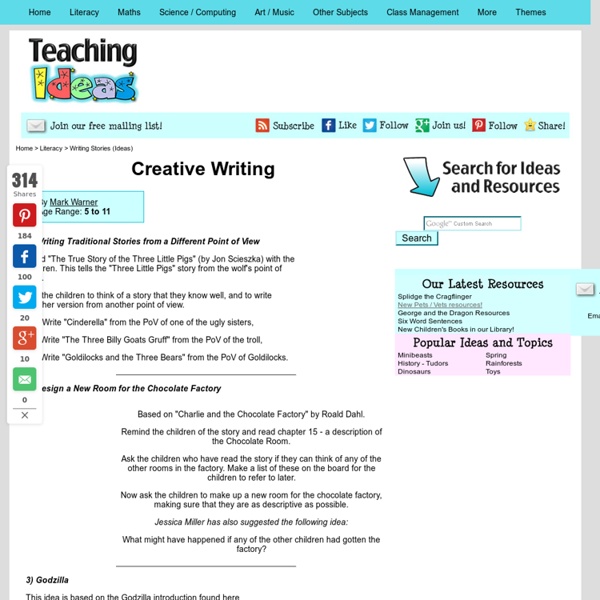everythingESL: The K-12 ESL Resource from Judie Haynes
Creative Writing 101: A Beginner's Guide to Creative Writing
Creative writing is any form of writing which is written with the creativity of mind: fiction writing, poetry writing, creative nonfiction writing and more. The purpose is to express something, whether it be feelings, thoughts, or emotions. Rather than only giving information or inciting the reader to make an action beneficial to the writer, creative writing is written to entertain or educate someone, to spread awareness about something or someone, or to express one’s thoughts. There are two kinds of creative writing: good and bad, effective and ineffective. So whether you’re a novelist, a poet, a short-story writer, an essayist, a biographer or an aspiring beginner, you want to improve your craft. When you write great fiction, poetry, or nonfiction, amazing things can happen. The best way to increase your proficiency in creative writing is to write, write compulsively, but it doesn’t mean write whatever you want. So here you have it, a beginners’ guide from Writers’ Treasure: Services
That Writing Lady | practical tips for teaching writing
Check out this great article about what happens when teachers and communities expect great things from every kid: School’s out for the summer, but rising seventh-grader Imani Blackshear is not on a break from reading or writing. She was at the school last week when I visited language arts teacher Salacthia Coast. That night, 42 middle school students from across the county took the stage and read their original works of fact, fiction, poetry and prose — hot off the presses and hot out of their notebooks from spring semester — but cool under the spotlight. Coast took the stage, too, with a lot of help. Coast said this past year was the first for East Broad to participate in DEEP. “It’s like the art of writing, that has been lost, is now being found,” Coast said. Blackshear was happy to tell me how the sessions went. “We got help from each other on how to express our ideas and help on writing better.
Monthly Themes: Safety
Writing Prompt Instructions: Playing sports, riding a bike, and crossing the street all require safety rules. Have students choose an activity and then write instructions for staying safe. Grades K–3 In Case of Fire Have students watch a demonstration of the steps in the “Stop, Drop, & Roll” safety technique. Grades K–3: Physical Education Water Colors Have students learn basic water safety rules. Boat Safety What do traffic lights and lighthouses have in common? Safe Children Have students review 15 general safety rules as they color. Fire Safety Tips Use these coloring pages to review fire safety tips with your students. Grades 1–5: Physical Education Bike Safety Cartoon Have students read about the Rules of the Road and view a cartoon about bicycle safety. Grades 1–8 Quizzes Test students' knowledge about safety. Grades 2–3 Safe on the Farm Ready Rooster has a lot to tell students about farm safety. Grades 2–3: Science Brrrr! Know What's Poisonous Grades 2–4 Food Safety Quiz Grades 2–5 Buckle Up! Grades 2–6
UCR: Department of Creative Writing
Creative writing tips for teachers: ideas and activities to inspire your class | Teacher Network | Guardian Professional
Engaging children and encouraging them to write has become increasingly difficult in the classroom. My children are bombarded with interactive and visual images constantly through the media and the internet and, as their teacher, it has become much harder for me to compete. Who wants to read or write an emotional descriptive piece when they can be fully immersed in this feeling through interactive game play? This challenge has led me to look at how I can use these media, and more dynamic approaches, to engage children in wanting to use their literacy skills and to hook them into becoming creative and thoughtful writers. Using video One way which is sure to engage children is through the use of video, in particular TV and film. For example, with my year 3 class I used the Jason and the Argonauts films to help them to explore the key features of the myths and legends genre. Non-fiction can be dealt with equally as well. Real life experience Cross curricular writing Adding drama
Teacher Resources, Kindergarten Welcome to Kinderteacher!
In the moonlight a worm... (Welcome to the Haiku Homepage)
Tips on Teaching Creative Writing
by Shirley Kawa-Jump It's finally happened. You've reached the pinnacle (or at least a peak) of your career: you've been asked to teach a creative writing class. Sounds easy, doesn't it? The problem is that what comes so naturally on paper is hard to explain, difficult to define and even more impossible to teach to others. 1. 2. 3. 4. 5. 6. 7. 8. 9. That give and take in the classroom resulted in a lecture that was enjoyable for me, both as a teacher and as a student. For More Information: Teaching Writing Online, by Moira Allen Tips on Conducting a Successful Workshop, by Moira Allen Copyright © 2001 Shirley Kawa-JumpThis article may not be reprinted without the author's written permission. Shirley Kawa-Jump, the author of How to Publish Your Articles: A Complete Guide to Making the Right Publication Say Yes, wrote her first published article at the age of eleven.



